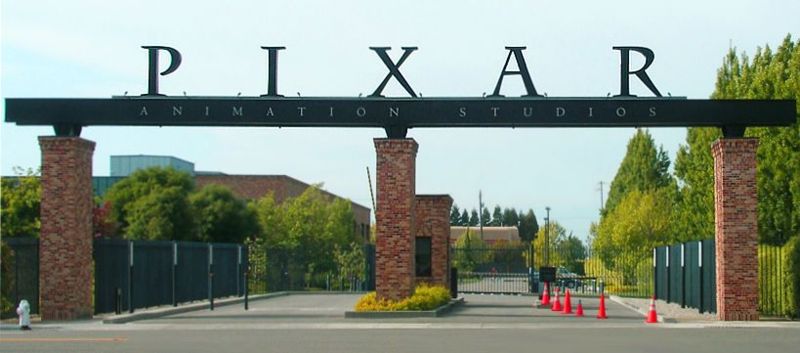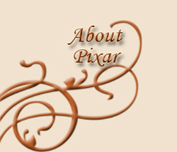|

About
Pixar Animation Studios is a CGI animation production company based in Emeryville, California, United States. To date, the studio has earned twenty-two Academy Awards, four Golden Globes, and three Grammys, among many other awards, acknowledgments and achievements. It is best known for its CGI-animated feature films which are created with PhotoRealistic RenderMan, its own implementation of the industry-standard Renderman image-rendering API used to generate high-quality images.
Pixar started in 1979 as the Graphics Group, a part of the Computer Division of Lucasfilm before it was bought by Apple co-founder Steve Jobs in 1986.
Pixar has made 10 feature films beginning with Toy Story in 1995 and each one has received critical and commercial success. Having won critical acclaim and commercial success with Toy Story in 1995, Pixar has followed it up with A Bug's Life in 1998, Toy Story 2 in 1999, Monsters, Inc. in 2001, Finding Nemo in 2003 (which is, to date, the most commercially successful Pixar film, grossing over $800 million worldwide), The Incredibles in 2004, Cars in 2006, Ratatouille in 2007, WALL-E in 2008 and Up in 2009 (the first Pixar film presented in Disney Digital 3-D). Their 11th film, Toy Story 3, is scheduled for release on June 18, 2010.
Since the inauguration of the Academy Award for Best Animated Feature in 2001, Pixar has been nominated 6 times and has won 4 of the awards.
Early History
Pixar was founded as the Graphics Group, one third of the Computer Division of Lucasfilm that was launched in 1979 with the hiring of Dr. Ed Catmull from the New York Institute of Technology (NYIT), where he was in charge of the Computer Graphics Lab (CGL). At NYIT, the researchers pioneered many of the CG techniques that are now taken for granted and worked on an experimental film called The Works. When the group moved to Lucasfilm, the team worked on creating the precursor to RenderMan, called Motion Doctor, which allowed traditional cel animators to use computer animation with minimal training.
The team began working on film sequences produced by Lucasfilm or worked collectively with Industrial Light and Magic on special effects. After years of research, and key milestones in films such as the Genesis Effect in Star Trek II: The Wrath of Khan and the Stained Glass Knight in Young Sherlock Holmes, the group, who counted about 45 individuals back then, was purchased in 1986 by Steve Jobs shortly after he left Apple Computer. Jobs paid $5 million to George Lucas and put $5 million as capital into the company. A factor contributing to Lucas' sale was an increase in cash flow difficulties following his 1983 divorce, which coincided with the sudden dropoff in revenues from Star Wars licenses following the release of Return of the Jedi and the disastrous box-office performance of Howard the Duck
The newly independent company was headed by Dr. Edwin Catmull, President and CEO, and Dr. Alvy Ray Smith, Executive Vice President and Director. Jobs served as Chairman and Chief Executive Officer of Pixar.
 Initially, Pixar was a high-end computer hardware company whose core product was the Pixar Image Computer, a system primarily sold to government agencies and the medical community. One of the leading buyers of Pixar Image Computers was Disney Studios, which was using the device as part of their secretive CAPS project, using the machine and custom software to migrate the laborious Ink and Paint part of the 2-D animation process to a more automated and thus efficient method. The Image Computer never sold well. In a bid to drive sales of the system, Pixar employee John Lasseter—who had long been creating short demonstration animations, such as Luxo Jr., to show off the device's capabilities—premiered his creations at SIGGRAPH, the computer graphics industry's largest convention, to great fanfare. Initially, Pixar was a high-end computer hardware company whose core product was the Pixar Image Computer, a system primarily sold to government agencies and the medical community. One of the leading buyers of Pixar Image Computers was Disney Studios, which was using the device as part of their secretive CAPS project, using the machine and custom software to migrate the laborious Ink and Paint part of the 2-D animation process to a more automated and thus efficient method. The Image Computer never sold well. In a bid to drive sales of the system, Pixar employee John Lasseter—who had long been creating short demonstration animations, such as Luxo Jr., to show off the device's capabilities—premiered his creations at SIGGRAPH, the computer graphics industry's largest convention, to great fanfare.
As poor sales of Pixar's computers threatened to put the company out of business, Lasseter's animation department began producing computer-animated commercials for outside companies. Early successes included campaigns for Tropicana, Listerine, and LifeSavers. During this period, Pixar continued its relationship with Walt Disney Feature Animation, a studio whose corporate parent would ultimately become its most important partner. In 1991, after substantial layoffs in the company's computer department, Pixar made a $26 million deal with Disney to produce three computer-animated feature films, the first of which was Toy Story. Despite this, the company was costing Jobs so much money that he considered selling it. Only after confirming that Disney would distribute Toy Story for the 1995 holiday season did he decide to give it another chance.
|
